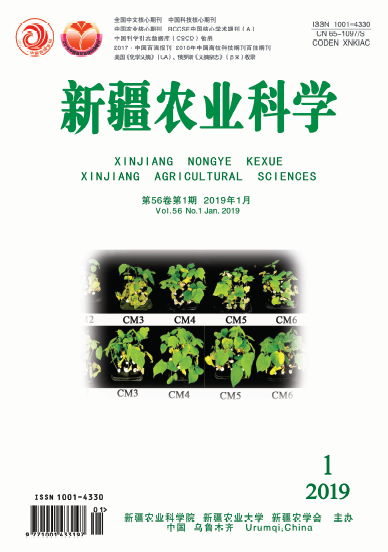|
|
Effects of Reduced Nitrogen Application on Dry Matter Accumulation and Yield of Cotton under Drip Irrigation in Northern Xinjiang
WEN Ming, LI Peng-bing, WANG Le, LI Ming-hua, LIU Yang, MA Fu-yu
2019, 56(1):
120-129.
DOI: 10.6048/j.issn.1001-4330.2019.01.015
【Objective】 To study the effects of reduced nitrogen application on cotton dry matter biomass and yield formation under drip irrigation in northern Xinjiang.【Method】The field experiment was conducted by using Lumianyan 24 as the testing material, and four different nitrogen application levels were set, including 506 kg/hm2 (N1), 402.5 kg/hm2 (N2), 299 kg/hm2 (N3), 195.5 kg/hm2 (N4). Among them, N2 treatment was the conventional nitrogen application rate used by local farmers and N3, N4 were the nitrogen reduction treatments.【Result】Under N3 treatment, the period of rapid accumulation of dry matter lasted the longest (42 days), 15, 19 and 15 days more than those under N1, N 2 and N4 treatments, respectively. In addition, under N3 treatment, the maximum rate of dry matter accumulation Vm was the smallest, 13.3%, 24.2% and 10.74% lower than those under N1, N2 and N4 treatments, respectively. The maximum rate of dry matter accumulation Vm of vegetative organs and reproductive organs in N3 treatment reached the maximum, and the maximum rate of dry matter accumulation Vm of vegetative organs in N3 treatment was 35.92%, 3.48% and 0.67% higher than those in N1, N2 and N4 treatments, respectively. The maximum accumulation rates of dry matter in reproductive organs treated with N3 were 52%, 22% and 19% higher than those treated with N1, N2 and N4, respectively. The yield of seed cotton under N2 treatment was the highest, reaching 5,938.34 kg/hm2, which was significantly higher than that under N1 and N4 treatment, but there was no significant difference between N3 and N2 treatments.【Conclusion】 High nitrogen promotes the distribution of dry matter to vegetative organs, while reducing nitrogen application rate in moderate level enhances the distribution of dry matter to reproductive organs. High nitrogen (N1) leads to vigorous vegetative growth in the middle and late stages of cotton, and moderate reduction of nitrogen application rate (N3) does not significantly reduce cotton yield. The optimum application rate of nitrogen for drip irrigation cotton in northern Xinjiang is about 299-402.5 kg/hm2.
|

